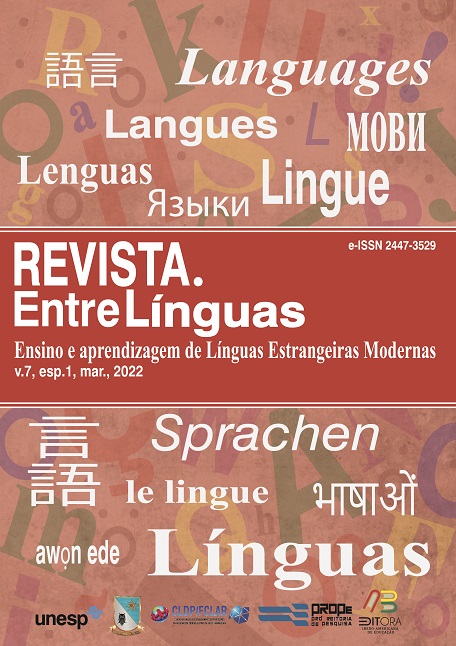Coronavirus vocabulary as a means of reflecting knowledge about a person
DOI :
https://doi.org/10.29051/el.v8iesp.1.16919Mots-clés :
Representation of knowledge about a person, Opposition concepts, Russian coronavirus vocabulary, Names of persons, Word-formationRésumé
The article examines the knowledge about a person that is represented by language units created during the coronavirus pandemic. These language units are formed using such methods as word-composition, affixation, substantiation, and blending and make up three lexical categories “coronavirus patients”, “law-abiding citizens who comply with antiepidemiological rules” and “violators of antiepidemiological rules”. The characteristics of the concepts represented by the language units of these three categories are described, it is shown that the concepts transmitted by the language units of the categories "law-abiding citizens who observe anti-epidemiological rules" and "violators of anti-epidemiological rules" can be considered as oppositional. Particular attention is paid to the analysis of the components used in word-composition and affixes, with the help of which derived units are created.
Téléchargements
Références
AKUT, K. B. Morphological Analysis of the Neologisms during the COVID-19 Pandemic. International Journal of English Language Studies, v. 2, n. 3, p. 1-7, 2020. Available in: https://al-kindipublisher.com/index.php/ijels/article/view/90. Access in: 26 Jan. 2021.
ASIF, M. et al. Linguistic analysis of neologism related to coronavirus (COVID-19). Social Sciences & Humanities Open, v. 4, n. 1, 100201, 2021. Available in: https://www.sciencedirect.com/science/article/pii/S2590291121000978?via%3Dihub. Access in: 20 Jan. 2021.
BURRIDGE, K.; MANNS, H. ‘Iso’, ‘boomer remover’ and ‘quarantini’: How coronavirus is changing our language. The Conversation, 2020. Available in: https://theconversation.com/iso-boomer-remover-and-quarantini-how-coronavirus-is-changing-our-language-136729. Access in: 07 Feb. 2021.
BUTSEVA, T. N.; ZELENIN, A. V. Lexicography in the situation of neological extreme (based on the material of neolexics associated with the coronavirus pandemic). Bulletin of Cherepovets State University, v. 6, n. 99, p. 86-105, 2020. Available in: https://www.elibrary.ru/item.asp?id=44387469. Access in: 27 Jan. 2021.
CATERMINA, V. V.; LIPIRIDI, S. H. Features of displaying the coronavirus pandemic in the vocabulary of medical discourse (based on English neologisms). Izvestiya Volgograd State Pedagogical University, v. 4, n. 147, p. 170-175, 2020. Available in: https://www.elibrary.ru/item.asp?id=42882761. Access in: 10 Feb. 2021.
DICTIONARY OF THE RUSSIAN LANGUAGE OF THE CORONAVIRUS ERA. Saint Petersburg: Institute of Linguistic Research of the Russian Academy of Sciences, 2021.
GEKKINA, E. N. Covid versus coronavirus: from observations of regular cases of derivational differences. In: SERGEEVNA, G. E.; SERGEEVNA, P. A.; NIKOLAEVNA, P. M. (eds.). New words and dictionaries of new words. Saint Petersburg: OR RAS, 2020.
GRISHKINA, E. N. The problem of correlation between the concepts of "neologism" and "new word" (psycholinguistic aspect). Yekaterinburg: Ural Federal University, 2016.
KHALFAN, M.; BATOOL, H.; SHEHZAD, W. Covid-19 Neologisms and their Social Use: An Analysis from the Perspective of Linguistic Relativism. Linguistics and Literature Review, v. 6, n. 2, p. 117-129, 2020. Available in: https://papers.ssrn.com/sol3/papers.cfm?abstract_id=3819563. Access in: 22 Jan. 2021.
MAP OF WORDS AND EXPRESSIONS OF THE RUSSIAN LANGUAGE. Kartaslov, n.d. Available in: https://kartaslov.ru. Acesso em: 11 Feb. 2021.
MINEEVA, Z. I. Neoderivaty in the Russian language of the pandemic era, In: New words and dictionaries of new words. In: SERGEEVNA, G. E.; SERGEEVNA, P. A.; NIKOLAEVNA, P. M. (eds.). New words and dictionaries of new words. Saint Petersburg: OR RAS, 2020.
MITURSKA-BOJANOVSKA, Y. Word-formation contamination in the era of coronavirus (based on colloquial speech and newspaper headlines). In: SERGEEVNA, G. E.; SERGEEVNA, P. A.; NIKOLAEVNA, P. M. (eds.). New words and dictionaries of new words. Saint Petersburg: OR RAS, 2020.
MOSKALEVA, M. V. Neologisms and the problem of their study in modern Russian. Proceedings of Herzen Russian State Pedagogical University, v. 80, p. 246–250, 2008. Available in: https://cyberleninka.ru/article/n/neologizmy-i-problema-ih-izucheniya-v-sovremennom-russkom-yazyke. Access in: 9 Jan. 2021.
PAVLOVA, A. S. The names of the COVID-19 coronavirus infection in Russian, English and German: cultural and national specifics. In: SERGEEVNA, G. E.; SERGEEVNA, P. A.; NIKOLAEVNA, P. M. (eds.). New words and dictionaries of new words. Saint Petersburg: OR RAS, 2020.
SAVCHENKO, A.V.; YAN-JUN, L. “Coronavirus neologisms”: From vocabulary and phraseology to Internet memes (based on the material of Russian and Chinese). Communicative research, v. 7, n. 4, p. 865-886, 2020. Available in: http://com-studies.org/images/magazine/2020/KI_4_2020.pdf. Access in: 19 Feb. 2021.
ZELENIN, A. V.; BUTSEVA, T. N. From sididomites to coronapophigists (Names of persons during the coronavirus pandemic). Russian language at school, v. 81, n. 6, p. 97-106, 2020. Available in: https://www.riash.ru/jour/article/view/1433. Access in: 24 Jan. 2021.
Téléchargements
Publiée
Comment citer
Numéro
Rubrique
Licence

Ce travail est disponible sous licence Creative Commons Attribution - Pas d’Utilisation Commerciale - Partage dans les Mêmes Conditions 4.0 International.
Os manuscritos aceitos e publicados são de propriedade da Revista EntreLínguas. Os artigos publicados e as referências citadas na Revista EntreLínguas são de inteira responsabilidade de seus autores.
Transferência de direitos autorais – autorização para publicação
Caso o artigo submetido seja aprovado para publicação, já fica acordado que o(s) autor(es) autoriza(m) a UNESP a reproduzi-lo e publicá-lo na EntreLínguas, entendendo-se os termos “reprodução” e “publicação” conforme definição respectivamente dos incisos VI e I do artigo 5° da Lei 9610/98. O artigo poderá ser acessado pela rede mundial de computadores (Internet), sendo permitidas, a título gratuito, a consulta e a reprodução de exemplar do artigo para uso próprio de quem a consulta, desde que haja a citação ao texto consultado. Essa autorização de publicação 328 EntreLínguas, Araraquara, v. 1, n .2, p. 323-328, jul./dez. 2015 não tem limitação de tempo, ficando a UNESP responsável pela manutenção da identificação do(s) autor(es) do artigo. Os artigos publicados e as referências citadas na Revista EntreLínguas são de inteira responsabilidade de seus autores.











